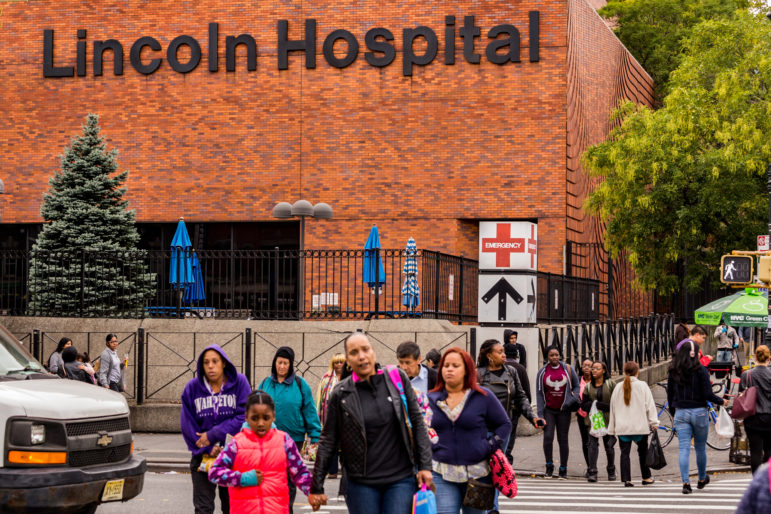‘For the Black and Latinx communities in a constant struggle over their health, a return to normal is not good enough—they need a health revolution. Building this new vision of health will require privileged New Yorkers to support the same tactics the Young Lords successfully deployed over 50 years ago.’

Adi Talwar
Lincoln Hospital in the South Bronx, where the Young Lords staged a 12-hour occupation in 1970 to demand better healthcare services for the community.In the late 1960s and early 1970s, New York City’s population was dropping, subway crime was picking up, and the city was barreling toward financial collapse. Against this backdrop, the New York Young Lords, a Latinx and Black-led political organization, rose to prominence. From seizing a City-operated x-ray truck for tuberculosis testing to reclaiming a church to provide social services and meals, the revolutionary group demonstrated that crisis demanded bold action.
Today, we face many of the same challenges as the 1970s with the addition of a global pandemic. As omicron cases recede, it is no surprise that many New Yorkers are hoping for a return to the normalcy of two years ago. However, for the Black and Latinx communities in a constant struggle over their health, a return to normal is not good enough—they need a health revolution.
Building this new vision of health will require privileged New Yorkers to support the same tactics the Young Lords successfully deployed over 50 years ago to address the medical, holistic, and social dimensions of health.
First, we must recognize the normalcy we yearn for provided inadequate medical care to Black and Latinx New Yorkers. In 1970, nurses and medical residents joined the Young Lords in occupying Lincoln Hospital in the South Bronx to demand better facilities and medical care. The 12-hour takeover successfully focused public attention on the failing hospital—nicknamed the “butcher shop” by its predominantly Latinx and Black patients—and it pushed then-Mayor John Lindsay to swiftly promise renovations.
READ MORE: Former Young Lords Reflect on Protests, Racism and Police Violence
In the intervening years, New York policymakers consistently stripped resources from safety-net and community facilities like Lincoln Hospital. Since 1998, these decisions have resulted in the closure of 18 medical facilities, many of which were in the exact neighborhoods that would be hardest hit by COVID-19.
Throughout the COVID-19 pandemic, social justice advocates and frontline workers, such as the nurses at NYC Health + Hospitals/Jacobi, have used direct action to draw attention to these gaps. If we value equitable medical care, we must stand in solidarity with these efforts, which call attention to the underfunding and understaffing of the medical facilities on which Black and Brown New Yorkers rely.
Second, we must elevate the holistic health approaches long pioneered by communities of color in the absence of access to formal, medicalized care. Shortly after taking over Lincoln Hospital, the Young Lords founded their own “People’s Clinic” to fight heroin addiction, which was then experienced by 20,000 people in the South Bronx. Inspired by Chinese opium detox approaches, the People’s Clinic provided acupuncture as an effective alternative to the standard medical treatment, methadone, which was invariably creating another dependence.
 CityViews are readers’ opinions, not those of City Limits. Add your voice today!
CityViews are readers’ opinions, not those of City Limits. Add your voice today!
Black, Indigenous, people of color use a range of holistic practices beyond acupuncture—from tai chi to Mayor Adams’ plant-based diet—many of which have the potential to effectively and efficiently address the chronic conditions that disproportionately impact Black and Brown New Yorkers and that led to their disparate COVID-19 health outcomes. For instance, a “food as medicine” approach that relies on the plant-based diets of our ancestors can successfully manage obesity, hypertension, diabetes, and heart disease, and there is some evidence that these approaches may decrease health care costs.
Adopting these practices, alongside higher quality medical facilities and care, would be a sweeping move in a city dominated by the greatest medical institutions in the country. However, given the scale of the disparities experienced by Black and Brown New Yorkers, we cannot financially or morally afford to sideline any approaches that can ensure the health of these communities.
Third, we must utilize a social determinants of health framework, which recognizes the role of non-medical factors, including the environment, in impacting health and wellbeing. In 1969, the Young Lords started the “Lead Offensive” campaign to raise awareness about childhood lead poisoning from paint in substandard housing. Working with health professionals from Metropolitan Hospital, the group conducted door-to-door lead testing and staged a sit-in at the Department of Health to demand unused lead testing kits.
Like childhood lead poisoning, the COVID-19 pandemic has demonstrated how social conditions—such as multigenerational housing or frontline employment—impact who is able to be “well.” These disparities underscore the necessity of advocating for a broader view of health that not only considers services to “feel better” but also the social structures that maintain inequality.
As New York City emerges from tough times once again, privileged New Yorkers must fight complacency. Instead, we must join Black and Brown New Yorkers in uplifting a new conception of health that prioritizes the medical, holistic, and social needs of marginalized communities. This investment will not bring New York City back to normal, but it can bring something better than normal: hope.
Sarah Batchu is the chief of staff at the Lower Eastside Girls Club and the interim director of the Center for Wellbeing and Happiness.








